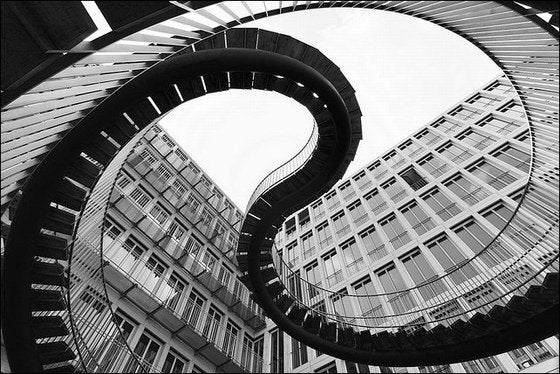
Our manufacturing base has long departed for China, but composer Annie Gosfield makes new music from the odds and ends of the old Industrial Age.
Some years ago she encountered an out-of-tune calliope on a riverboat in New Orleans and, as she describes, became fascinated with "old mechanical instruments, and the odd, detuned sounds that they produce as they deteriorate. As time takes its toll on these great beasts, the tunings become increasingly random, pipes warp, hammers wear out, and tempos slip and slide as their timing mechanisms fluctuate."
This early epiphany tapped deeply into Gosfield's aesthetic DNA, and she expanded that initial impression into a full-blown obsession with the sounds of all kinds of utilitarian hardware, from tiny typewriters to titanic factories.
The pompadour-coiffured, diminutive composer has since created several musical analogues of clanging, wheezing, sputtering, and chugging contraptions. She has assumed the role of a musical Charlie Chaplin trapped in the giant gears of Modern Times, as well as a keyboard-sampler artist with the deadpan efficiency of Buster Keaton commandeering The General.
Five of her musical-machine compositions were presented last Saturday to audiences more accustomed these days to the virtual silences of the computer age. Gosfield's peculiar remembrance of noises past was introduced with a video projection from 1999, Shoot the Player Piano (The Treasures of San Sylmar), opening a program at the club Fais-do-do entirely devoted to her works.
The video was shot at The Nethercutt Collection in Sylmar, California, a museum of pneumatic instruments gathered over the years by the developer of Merle Norman cosmetics. These machines -- calliopes, nickelodeons, and German jahrmarkt organs -- were visually juxtaposed in fast crosscuts, their sounds mixed with those of the more conventional violin, piano, accordion and banjo, all of them deconstructed via musical sampler that detuned, altered, and arranged the rhythmic whimsy into an "imaginary orchestra" soundtrack.
The gentle lunacy continued in Four Roses for cello and sampler (1997), a study in harmonics as the cello's "A" string was tuned "80 cents flat," just enough to throw off odd overtones as the instrument interacts with a prepared piano, tuned to a scale with 32 notes per octave (normally twelve). Four Roses suggests a three-sheets-to-the-wind romance. And, as the composer explains, the title "is the name of a rather inexpensive whisky favored by my parents while they were courting." Maggie Parkins was the cellist with the composer holding forth on a sampler.
Flying Sparks and Heavy Machinery, for string quartet and a battery of percussion (2000), is a monumental compendium of industrial manufacturing sounds, appropriately inspired by Gosfield's residency at the factories of Nuremberg's Siemens Corporation. (Interestingly, Gosfield chose heavy-industry exporter Germany, not the once thriving industrial USA, for her sound-laboratory residency.)
One hears the scraping of steel surfaces in the quartet's micro-tuned strings, the heaving, irregular start of massive engines in sputtering drum riffs, and the sonic echoes of a warehouse of machinery on octaves alternating up and down between violins, viola, and cello. Gosfield has a way in this and most of her other pieces of cranking up power through a gathering rhythmic intensity and then letting it dissipate, as if on lunch break, only to crank up again after a buzzer signals time again for work. A crack unit of something like forty percussion instruments (M.B. Gordy, Nicholas Stoup, Lauren Kosty, Andrea Moore) was assembled for the evening, joined by the virtuosic Eclipse Quartet (Sarah Parkins, violin; Sarah Thornblade, violin; Alma Lisa Fernandez, viola; Maggie Parkins, cello) in a tour de force performance worthy of recording.
EWA7 (1999), named for a factory in Nuremberg, was inspired by the same Siemens residency, and further explored musical possibilities in "scrapes, squeaks, and bangs of metal, the ambient buzzes and whines of electric devices, and the imperfect rhythmic repeats of heavy machinery." Composed for sampler (Gosfield), wailing guitar (Roger Kleier), and virtuoso drums/percussion (Joe Berardi), the musical feel was of a powerful but cruder variation of the above Sparks, this time in a rock-inflected, heavy metal style, like a long Grateful Dead instrumental from the 70's pounding relentlessly to conclusion.
Lost Signals and Drifting Satellites (2003) for violin (Mark Menzies) and prerecorded sounds of satellites, shortwaves and radio transmissions had a back to the future, lost in space feel, like an old science fiction movie, with the violin signal at first oblivious of its static filter, but then interacting with the accompanying space sounds as the composition progressed.
Although she was inspired by her own chance encounter with real-life phenomena, Gosfield is a direct successor to such twentieth century futurist composers as Edgard Varèse, Luigi Russolo, and John Cage. The three had embraced the everyday clatter of America's machine-age as a periphery of noise to be shaped into expressive sound worlds. Gosfield's contribution has been to capture and organize, with her pointillistic montages, the precise colors, energies and consequences of the world of function as unintentional but beautiful form.
Gosfield's aesthetic of harvested noise reminds me of a gig I once had using electronic music to open a modern music marathon at the Hollywood Bowl. In those days, selling an audience on such fare in the concert hall was tough sledding. But out of doors, the "random" sounds of Edgard Varese, Morton Subotnick, and Pauline Oliveros were as normal and therefore accepted as birdcalls, traffic noise, audience chatter, or wine bottles dropped carelessly on cement.
In the music of arranged noise, context is all.
Rodney Punt can be reached at Rodney@artspacifica.net